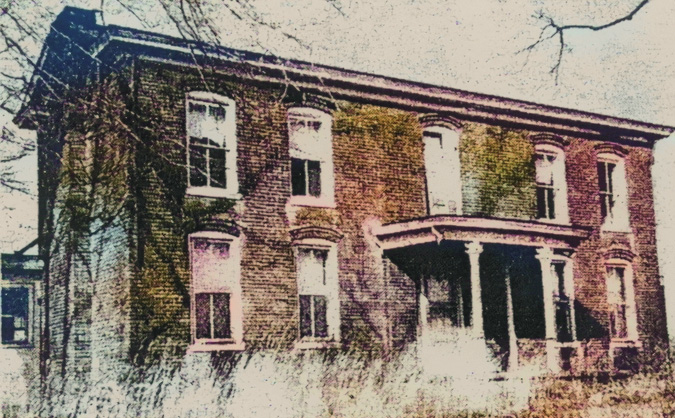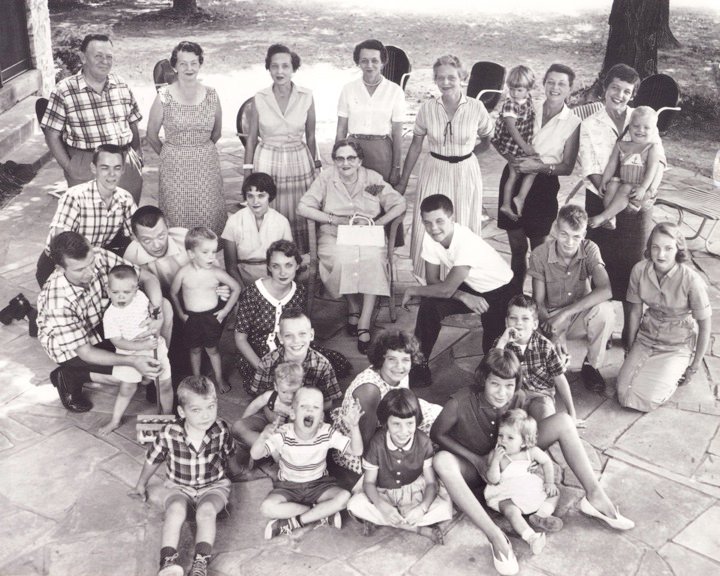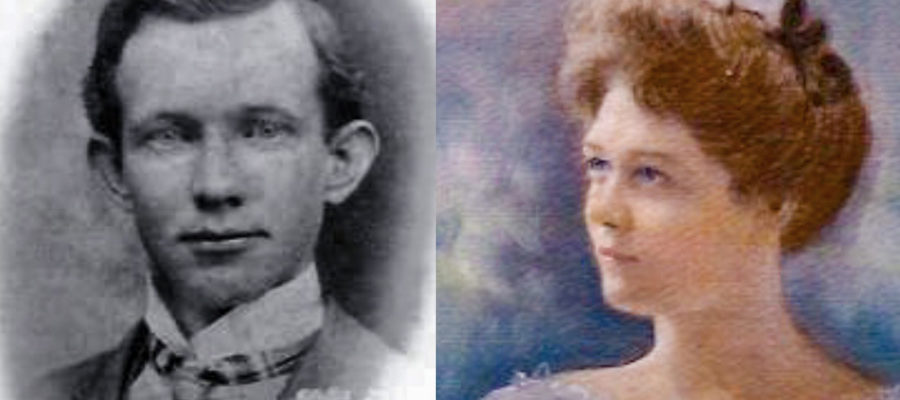We who call ourselves the Ballantines of Kentucky are all descendants (or married to or adopted by) of Tilden Hendricks Ballantine and Wilmot Austin Bewley of Rumsey and Calhoun in McLean County, Kentucky. We don’t call ourselves the Bewleys because marriage was (and still is) a patriarchal institution, and because we know less about them.
The Bewleys were originally English, from Kent. They were in America long before the Revolutionary War, mostly in Pennsylvania. Some were in Virginia in the early 19th century, and then across the mountains to East Tennessee and western Kentucky in 1830. The Bewley tree had many branches, and distantly-related Bewleys can be found today in several parts of the Upper South and the Midwest as well.
Kentucky has more navigable waterways than any other state besides Alaska, and our McLean County Bewleys were riverboat people. Wilmot’s father George Bewley once commanded a “snagboat” clearing the Ohio and later captained several sternwheel packets as well. Wilmot’s uncle Elmore Bewley was Captain and half-owner (along with Tilden’s father) of the steamboat Gayoso, and later the Bowling Green, which plied the Green, Barren and Pond rivers.
 The Ballantine side of our family has a somewhat different story. They came, one family, all in a bunch in 1849, from the north of Ireland. Which doesn’t make us Irish.
The Ballantine side of our family has a somewhat different story. They came, one family, all in a bunch in 1849, from the north of Ireland. Which doesn’t make us Irish.
We’re Scots-Irish, a different breed with a very different story.
Ireland was conquered by England in 1400 but never subdued. The rebellious Irish were most dangerous in the north called Ulster, and in the 17th century Lowland Scots were recruited (forced, lured?) by the English to the “Ulster Plantation” where they were given the homes and farms of the Irish who were being driven out.
The Lowland Scots were themselves a troublesome bunch, often preying on livestock, travelers, and merchants along the rather porous, uncertain, and shifting southern border with England. (The “Border-Rievers” as they were called included Ballantynes.) But they spoke Scots, a dialect of English, and were mostly Protestant, unlike many of the Highland Scots and all the Irish, who were Catholic. They looked to the English like possible allies.
In the century between 1610 and 1717 perhaps as many as 100,000 Lowland Scots were “transported,” until there were some five Scots to every three Irish and one Englishman in Ulster.
The Ulster-Scots were often uncertain allies, as they rejected the high-church tendencies of the Anglican (official English) church. Plus they were sorely resented by the Catholic Irish minority in Ulster. Eventually, many moved on to Canada, Australia, and the USA.
Those who remained grew more sternly English as time went on, and today Ulster (officially, Northern Ireland) is part of Great Britain along with all of Scotland, Wales, and England. Irish patriots still mourn the loss of the “Six Counties,” and Sinn Fein (the IRA) and the Protestant “Orangemen” still clash in Northern Ireland, the last area in Europe where the Reformation has remained a bloody business.
The Ulster-Scots who left for America came seeking land and personal freedom. They found both in the Appalachians and the Ohio Valley, recently seized or stolen from the native “Indians” just as Ireland had been stolen from the Irish. Today, known as the Scots-Irish, they predominate in the American South. That’s us.
Some historians claim the Scots-Irish are the first “Americans,” having no identification with their origins. An old song claims:
And we’ll join the jubilation for the thing that we are not;
For we say we aren’t Irish, and God knows we aren’t Scot!
Mary and William Ballantine lived in Gortavilly, County Tyrone, but for how long we don’t know. Farmers, they either owned or rented ten acres, which was a pretty good spread in Ulster. They raised flax, the main cash crop of the area.
Their eldest son John emigrated to America in 1839 or so. This was just after the “Big Wind,” a terrible rogue hurricane that devastated Ireland, and just before the disastrous Potato Famine of 1845
John was a stonecutter, a skilled trade. By 1842 he owned land in Rumsey. In 1849 he sent for his parents and several sisters and brothers, including his “baby brother” Henry, 12 at the time. They sailed from Liverpool, England, to New Orleans. Three rivers, the Mississippi, the Ohio, and the Green brought them to McLean County, Kentucky (then a part of Muhlenberg County).
We don’t know, but I’m guessing, that John paid their way.
Calhoun and Rumsey, one small and the other tiny, sit holding hands across the Green River, western Kentucky’s major river—excepting, of course, the mighty Ohio, Kentucky’s longest border and the Mason-Dixon line.
The Green is never mighty but always beautiful, narrow but highly navigable, winding deep into rich tobacco, timber and coal country. The dam and lock between Calhoun and Rumsey, saw lots of boats, carrying trade and passengers between Bowling Green and Evansville, Indiana, the nearest big city on the north (Indiana) shore of the Ohio. In the spring, when the Green ran high, huge rafts of cypress logs were floated downriver to Evansville for busy furniture factories.
McLean County on the Green River was not a sleepy area. The Bewleys and the Ballantines were drawn there, and stayed and prospered.
Both Tilden and Wilmot were born in Rumsey, Tilden in 1876 and Wilmot four years later. Their two families were close and so were they, as toddlers (Nancy Bewley often allowed Tilden to push her daughter’s buggy), then as playmates, schoolmates, best friends, and more. Nancy Bell assured us that her parents “always knew who they were going to marry.”
But Tilden had his own sorrows. His mother, Josephine (McGrew), died when he was only four months old. He had three older sisters who helped his distracted and grieving father raise him. But Tilden felt resented or abandoned as much as loved.
 Henry Ballantine married again when Tilden was only five. His stepmother, Josie (Landrum), was from another important McLean County family, the Landrums. She might have provided the mothering Tilden never had, but she bore him a half-brother, Henry Thomas, and died soon after, at only 24.
Henry Ballantine married again when Tilden was only five. His stepmother, Josie (Landrum), was from another important McLean County family, the Landrums. She might have provided the mothering Tilden never had, but she bore him a half-brother, Henry Thomas, and died soon after, at only 24.
After losing two young wives in less than five years, Henry Ballantine never married again. He devoted his life to work and business: farming, timbering, and buying and selling real estate. By 1899 he was the wealthiest man in McLean County, worth almost $20,000.
Tilden and Wilmot married in 1900 and had eight children: Tom, Eleanor, Katie Dee, Elizabeth, Gordon, Jane, Martha, and Nancy. They bought the farm and “big house” in Rumsey when Henry died in 1903.
Tilden farmed and ran the ferry connecting Rumsey and Calhoun until the bridge in 1935 ended that. They lived in the big house on the farm in Rumsey until 1920, when they bought a big house in Calhoun right on the river at the ferry landing. It was a hotel before they bought it. They made it a house, and then a happy home.
There were hard times, like the Great Depression and the 1937 flood when the water in the Calhoun house was 3-4 feet deep. The Ballantines lived upstairs and took in as many refugees as they could. Sad times too, as Nancy Austin Bewley, Wilmot’s widowed mother who was living with them, lived out her last unhappy years. Nancy Ballantine, named for her grandmother, sat on her lap and heard her saddest memory many times:
It was 1882. Nancy’s little sister, Nora Austin, was only 17. She was gathering wild grapes with her family near the Pond River, when a rejected ex-suitor, Buck Cook, appeared with a gun. He shot Nora and then himself. Nora died “with the stain of the grapes still on her lips.” Nancy Austin Bewley died with that long-ago sorrow still in her heart in 1938.
The next year, 1939, brought a closer tragedy. Gordon, the youngest brother, the loving, playful, favorite of all the family, died suddenly at 28 of an perforated ulcer. Gordon lived in Illinois and had just returned from a Christmas visit to the family in Calhoun. He died in the hospital with his wife, Marion, but none of his many sisters, by his side.
Some broken hearts never heal, and there have been Gordons in every Ballantine generation since. Along with Tilden, it’s a family favorite name.
Once the youngest and now the patriarch of the family, Henry Ballantine provided for all his children, and a niece and nephew as well as well after his brother Moses drowned in the Green River. But it seems he provided more money than love. It was said that Henry could be cold, distant, irascible, easily angered and super critical. After he died, Tilden complained that “He never gave me even a little red wagon.” Only Wilmot was fond of him, and he loved her, perhaps because she gave so much to his estranged son. His grandchildren often feared him and avoided him. Henry Ballantine was a stiff, proud Confederate veteran, and it was as such that he left his indelible mark on the family.
Kentucky was a slave state, but the Ballantines owned no slaves. Kentucky never successfully seceded, and it was occupied by Union troops early on, but it had a star (the 13th) in the “Rebel” battle flag and representatives in the Confederate Congress in Richmond.
Joseph and Henry, the Ballantine “baby brother” at 24, enlisted in the Confederate army in 1861. Henry served in the 8th KY mounted infantry, CSA, was captured in the Battle of Fort Donelson and was a prisoner of war for a time. Freed in an exchange, he served with Nathan Bedford Forrest’s famous (and notorious) cavalry as First Sergeant (the CSA’s highest non-com rank) until Lee surrendered at Appomattox in 1865 and the Civil War was over. Henry was wounded once but both he and Joseph survived the war.
Henry’s Confederate predilections and loyalties were front and center when Tilden Hendricks Ballantine was born in 1876. The defeated South resented and feared the citizenship and civil rights that post-war Reconstruction was granting to the former slaves. The disputed presidential election of 1876 put an end to that. The Democratic Tilden/Hendricks ticket tied with the Republican Hayes/Rutherford ticket. A deal was struck, the Compromise of 1877, at the expense of Blacks. The Republicans took the Presidency and, in return, agreed to abandon Reconstruction in the South. White supremacy was restored.
This was the “Great Betrayal” (according to W.E.B. DuBois) which doomed Black Americans to second-class status for almost a century. Voting rights of Blacks were violently stripped away, Jim Crow and segregation were made law, the “Lost Cause” was celebrated with Confederate statues and memorials all over the South, and lynchings and KKK terror became common. This abandonment of Reconstruction and restoration of White Supremacy was celebrated as “The Redemption” by many whites in the South.
Our most beloved family name, Tilden Hendricks, is certainly a “Redemptionist” name.
No infant names himself, and it is doubtful that Tilden Hendricks Ballantine shared Henry’s un-reconstructed Confederate sympathies. A popular and fair-minded man, Tilden was known as a “gentle soul” who cried whenever his daughters married, which made for many tears. “Captain Ballantine’s” ferry was a busy public institution, and he knew everyone. He was active in Democratic politics, and later became president of Citizens Deposit Bank and Mayor of Calhoun.
It was Wilmot, the grandmother known to my generation as “Calhoun Mama,” who ran the family.
The bigger girls raised the younger ones (a common practice at the time) and Wilmot ran the kitchen, the pantry, the smokehouse, and kept the books. Tilden ran the ferry but Calhoun Mama drove the car. She ran Calhoun’s only movie theatre (the Victory)for a time. She bore her last child, Nancy, when she was 44. Nancy, the only Ballantine born in Calhoun, once described herself as “The only city kid in the bunch.”
Growing up in Calhoun, Nancy told me, was wonderful. It was of course segregated but “we knew everybody, Black and white. We knew where they lived. We knew the names of their children and the names of their dogs.” Our family became known as “Roosevelt Democrats” during the Depression and the New Deal. Ballantines and Bells played a role in desegregating Louisville schools, and Nancy Bell was a Robert Kennedy (anti-war) supporter and personal friend. Our long and honorable history as Southern liberals is perhaps exemplified best by Thomas A. Ballantine Jr’s appointment as U.S. District Court Judge by President Jimmy Carter in 1991.
Tom, the first-born of Tilden and Wilmot, moved to Louisville after law school at UK, and Nancy, the youngest, moved to Louisville in 1942. The rest of that first generation remained in western Kentucky, mostly Owensboro and nearby Madisonville. Tilden died of cancer in 1941. Calhoun Mama died in 1968 in Owensboro, where she lived among her many children and grandchildren.
Nancy Ballantine Bell was the last of that first generation to die, in 2016. She lived well into her nineties with her famous humor and love for family intact. A few years before, when she was in a wheelchair, she pulled me down to her side in Louisville. Long the beloved Matriarch of the Ballantines, she whispered with a sly smile, as if sharing a family secret: “We always thought we were something special. But we weren’t.”
But we were.
—by Terry B. Bisson from Interviews
and Research by Beverley Ballantine


